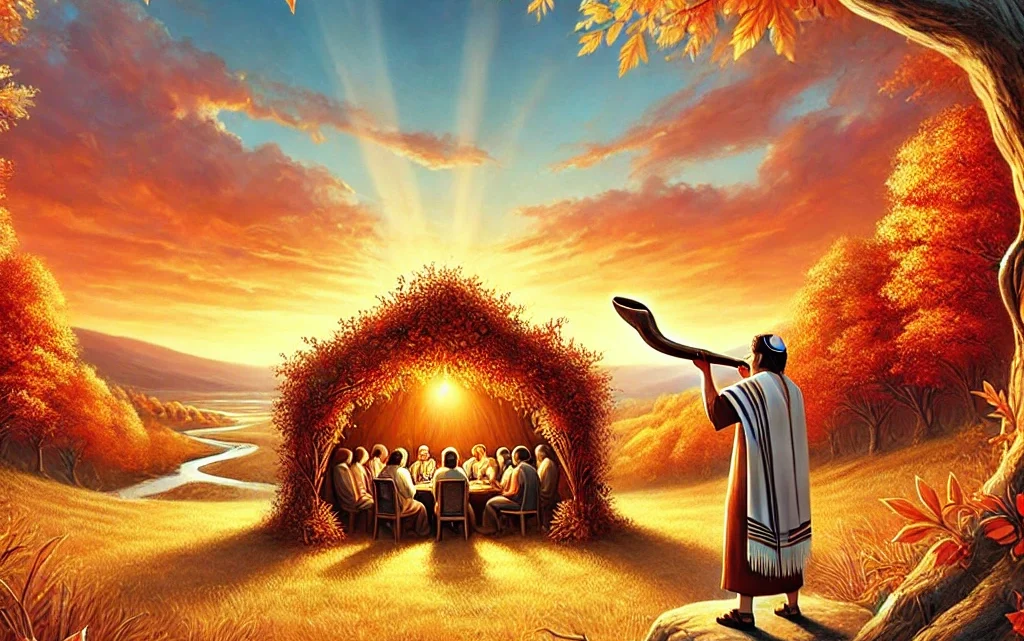Embracing the Beauty of Fall Feasts: A Journey Through Scripture and Tradition

Introduction
The fall season brings with it a time of reflection, renewal, and reconnection with the divine, especially as we observe the biblical Fall Feasts. Deeply rooted in the Hebrew scriptures, these feasts serve as a spiritual roadmap, guiding believers through a season of introspection, repentance, and celebration of God’s eternal covenant with His people. In this post, we will journey through the beauty and significance of the Fall Feasts, understanding how these ancient observances, rooted in both scripture and tradition, are relevant today.
I. Feast of Trumpets (Yom Teruah) – The Awakening Blast
Yom Teruah, often called the Feast of Trumpets, heralds the beginning of the fall festivals and is marked by the sounding of the shofar (a ram’s horn). This sound is not just a ceremonial blast—it is a divine wake-up call, stirring the hearts of believers to prepare for the coming days of repentance and reflection.
As it is written in Leviticus 25:9:
“And it shall be at the blow of the shofar, on the tenth day of the seventh month, when you sound the shofar throughout your land, that all the inhabitants of the land shall tremble.”
The shofar’s piercing sound is meant to remind us of Yehovah’s presence and the importance of aligning our hearts and lives with His will. It is a time to awaken from spiritual slumber, assess our relationship with Him, and prepare for the Day of Atonement.
II. Day of Atonement (Yom Kippur) – The Sacrifice of Reconciliation
Following Yom Teruah, Yom Kippur is considered the holiest day of the biblical calendar. It is a day of fasting, prayer, and repentance, where we seek Yehovah’s forgiveness and reconcile ourselves to Him. Yom Kippur emphasizes the gravity of sin and the merciful provision of atonement, pointing ultimately to Yeshua, whose sacrifice allows us to be cleansed of all unrighteousness.
Leviticus 16:30 reminds us:
“For on this day atonement will be made for you, to cleanse you. Before the Lord you shall be clean; from all your sins you shall be clean.”
On Yom Kippur, we humble ourselves, acknowledging our dependence on Yehovah’s mercy. It is a solemn day that leads to restoration and a renewed commitment to living a holy life in His presence.
III. Feast of Tabernacles (Sukkot) – The Celebration of God’s Provision
Immediately following Yom Kippur is the Feast of Tabernacles, or Sukkot, a time of joy and celebration. Sukkot commemorates Yehovah’s provision for the Israelites during their 40 years in the wilderness, as well as His ongoing provision for us today. During this feast, temporary booths or “sukkot” are constructed, reminding us of the fragility of life and our reliance on Yehovah for sustenance and protection.
Deuteronomy 16:15 declares:
“Rejoice before the Lord your God with all manner of joy, for He has given you the good land.”
Sukkot is a time to remember the abundant blessings Yehovah provides, both spiritual and physical. It is a celebration of His continued presence with us, as we acknowledge our dependence on Him for all things.
IV. Shemini Atzeret – The Final Gathering
Following the week-long celebration of Sukkot is Shemini Atzeret, often viewed as the conclusion of the Fall Feasts. It is a time to linger in Yehovah’s presence, reflecting on the spiritual lessons learned throughout the festival season and rejoicing in the intimacy we share with Him.
Shemini Atzeret invites us to pause and appreciate the closeness of our relationship with Yehovah, celebrating His faithfulness as we prepare for the year ahead.
V. Historical Significance and Traditions of the Fall Feasts
The Fall Feasts have deep roots in biblical history, with their origins outlined in the Torah. These feasts were instituted by Yehovah as appointed times, “moedim,” for His people to reflect on their relationship with Him and His covenant promises.
• Yom Teruah: Historically observed as the “Day of Remembrance,” calling the people to consider the coming Day of Atonement.
• Yom Kippur: Marked by fasting and prayer, reflecting the ancient practice of the high priest entering the Holy of Holies to make atonement for the people.
• Sukkot: Remains a joyous celebration of harvest and divine provision, with many today continuing the tradition of building temporary booths and living in them during the feast.Today, these feasts are celebrated by Jews worldwide and many believers in Yeshua who see in them a beautiful prophetic picture of the Messiah’s work and coming Kingdom. Each feast is filled with rich symbolism and invites us to pause, reflect, and embrace Yehovah’s eternal love and faithfulness.
Conclusion
As we immerse ourselves in the beauty of the Fall Feasts, we are reminded of Yehovah’s everlasting covenant with His people. These feasts guide us through a journey of repentance, reconciliation, and rejoicing in Yehovah’s provision. As we sound the shofar, fast in humility, dwell in temporary booths, and gather to linger in His presence, may we be filled with a deep sense of gratitude for His eternal love, His unending mercy, and His abundant blessings.
May the observance of these holy days inspire us to live lives of righteousness and service, reflecting the light of Yehovah in all we do.

